Comparative Study on the Fractal and Fractal Dimension of the Vortex Structure of Hydrofoil’s Tip Leakage Flow
Abstract
1. Introduction
2. Research Subject
3. Mathematical Methods
3.1. Turbulence Model
3.2. Orthogonal Experiment Method
3.3. Fractal Dimension
4. Computational Fluid Dynamics Simulation
4.1. Computing Domain Grid Division
4.2. Computational Fluid Dynamics Setups
- (1)
- The inlet is set as velocity inlet, the inflow velocity Vin is determined according to the orthogonal experiment table, and the turbulence intensity is set as 1%.
- (2)
- The outlet is pressure outlet, and the outlet pressure is set as 0 Pa.
- (3)
- The other walls are no-slip walls.
4.3. Comparison between the Experiment and Numerical Simulation
5. Analysis of the Orthogonal Experiment Results
5.1. Effect of Different Parameters on the Pressure Coefficient of the Vortex Core
5.2. Effect of Different Parameters on the Vortex Core Velocity
5.3. Effects of the Different Parameters on the Longitudinal Position of the Vortex Core
5.4. Effects of the Different Parameters on the Length of Leakage Vortex
5.5. Effect of the Different Parameters on the Leakage Vortex Angle
6. Fractal Dimension Analysis
6.1. Coarse Grained Analysis Method
6.2. Image Processing Process
6.3. Spatial Evolution of the Tip Leakage Vortex
7. Conclusions
- (1)
- Through the range analysis of different parameters on the pressure coefficient, velocity coefficient, longitudinal position, angle, and length of the TLV, it can be found that the gap width has the greatest effect on the TLV. When the gap width increases, the pressure coefficient of the TLV core decreases first and then increases, the minimum pressure coefficient is about –2, the velocity coefficient of the vortex core increases first and then decreases, and the longitudinal position of the TLV core and the angle of the TLV continue to decrease, the length of TLV increases continuously;
- (2)
- The incidence angle has little influence on the TLV. With the increase of the hydrofoil attack angle, the TLV core pressure coefficient, the TLV core velocity coefficient, and the length of the TLV decrease, and the longitudinal position and the TLV angle of the vortex core increase. The inlet velocity has the least effect on the TLV. With the increase of the inlet velocity, the core pressure coefficient and longitudinal position of TLV gradually increase, while the core velocity coefficient decreases first and then increases, while the length and angle of leakage vortex remain basically unchanged;
- (3)
- In this article, the λ2 method is used to show the vortex structure generated by hydrofoil clearance flow, and the plane with different flow direction positions is used to intercept the vortex morphology. Through the analysis of vortices on different sections, the variation of the vortex number and fractal dimension along the flow direction is obtained. We can see that the fractal dimension of the leakage vortex decreases gradually from S1 to S3, and its fractal dimension is between 1.2 and 1.4. When the gap width is small, the logarithm of the circumference and area of the tip leakage vortex presents an obvious linear relationship, and the goodness of fit is above 0.99.
Author Contributions
Funding
Institutional Review Board Statement
Informed Consent Statement
Data Availability Statement
Conflicts of Interest
References
- Liu, Y.; Tan, L.; Wang, B. A Review of Tip Clearance in Propeller, Pump and Turbine. Energies 2018, 11, 2202. [Google Scholar] [CrossRef]
- Wu, H.; Miorini, R.L.; Katz, J. Measurements of the Tip Leakage Vortex Structures and Turbulence in the Meridional Plane of an Axial Water-Jet Pump. Exp. Fluids 2011, 50, 989–1003. [Google Scholar] [CrossRef]
- Zhang, D.; Shi, W.; Pan, D.; Dubuisson, M. Numerical and Experimental Investigation of Tip Leakage Vortex Cavitation Patterns and Mechanisms in an Axial Flow Pump. J. Fluids Eng. Trans. ASME 2015, 137, 121103. [Google Scholar] [CrossRef]
- Lin, F.; Chen, J. Oscillatory Tip Leakage Flows and Stability Enhancement in Axial Compressors. Int. J. Rotating Mach. 2018, 2018, 9076472. [Google Scholar] [CrossRef]
- Wang, J.; Cheng, H.; Xu, S.; Ji, B.; Long, X. Performance of Cavitation Flow and Its Induced Noise of Different Jet Pump Cavitation Reactors. Ultrason. Sonochem. 2019, 55, 322–331. [Google Scholar] [CrossRef] [PubMed]
- Zhang, D.; Shi, W.; Chen, B.; Guan, X. Unsteady Flow Analysis and Experimental Investigation of Axial-Flow Pump. J. Hydrodyn. Ser. B 2010, 22, 35–43. [Google Scholar] [CrossRef]
- Kim, S.; Choi, C.; Kim, J.; Park, J.; Baek, J. Tip Clearance Effects on Cavitation Evolution and Head Breakdown in Turbopump Inducer. J. Propul. Power 2013, 29, 1357–1366. [Google Scholar] [CrossRef]
- Sentyabov, A.; Timoshevskiy, M.; Pervunin, K.S. Gap Cavitation in the End Clearance of a Guide Vane of a Hydroturbine: Numerical and Experimental Investigation. J. Eng. Thermophys. 2019, 28, 67–83. [Google Scholar] [CrossRef]
- Tan, D.; Li, Y.; Wilkes, I.; Vagnoni, E.; Miorini, R.L.; Katz, J. Experimental Investigation of the Role of Large Scale Cavitating Vortical Structures in Performance Breakdown of an Axial Waterjet Pump. J. Fluids Eng. Trans. ASME 2015, 137, 111301. [Google Scholar] [CrossRef]
- Peng, X.; Zhang, L.; Wang, B.; Xu, L.; Song, M.; Cao, Y.; Liu, Y.; Hong, F.; Yan, K. Study of Tip Vortex Cavitation Inception and Vortex Singing. J. Hydrodyn. 2019, 31, 1170–1177. [Google Scholar] [CrossRef]
- Qian-xi, W.; Yuan-xiang, Y.; Tan, D.S.; Jian, S.; Tan, S.K. Non-Spherical Multi-Oscillations of a Bubble in a Compressible Liquid. J. Hydrodyn. 2014, 26, 848–855. [Google Scholar] [CrossRef]
- Zhao, M.; Zhao, W.; Wan, D. Numerical Simulations of Propeller Cavitation Flows Based on OpenFOAM. J. Hydrodyn. 2020, 32, 1071–1079. [Google Scholar] [CrossRef]
- Wang, X.; Zhang, J.; Huang, Z.; Wang, L.; Li, W.; Lan, G. Large Eddy Simulation on the Cavitation Flow and Noise Characteristics of a NACA0009 Hydrofoil with Different Tip Clearance Sizes. J. Fluids Eng. 2023, 145, 011204. [Google Scholar] [CrossRef]
- Bi, Z.; Shao, X.; Zhang, L. Numerical Study of Tip Leakage Vortex around a NACA0009 Hydrofoil. J. Fluids Eng. 2021, 143, 5. [Google Scholar] [CrossRef]
- Xiao, X.; McCarter, A.A.; Lakshminarayana, B. Tip Clearance Effects in a Turbine Rotor: Part I—Pressure Field and Loss. J. Turbomach. 2001, 123, 296–304. [Google Scholar] [CrossRef]
- Wenger, C.W.; Devenport, W.J.; Wittmer, K.S.; Muthanna, C. Wake of a Compressor Cascade with Tip Gap, Part 3: Two-Point Statistics. AIAA J. 2004, 42, 2341–2346. [Google Scholar] [CrossRef]
- Muthanna, C.; Devenport, W.J. Wake of a Compressor Cascade with Tip Gap, Part 1: Mean Flow and Turbulence Structure. AIAA J. 2004, 42, 2320–2331. [Google Scholar] [CrossRef]
- Geng, L.; Zhang, D.; Chen, J.; Escaler, X. Large-Eddy Simulation of Cavitating Tip Leakage Vortex Structures and Dynamics around a NACA0009 Hydrofoil. J. Mar. Sci. Eng. 2021, 9, 1198. [Google Scholar] [CrossRef]
- Decaix, J.; Balarac, G.; Dreyer, M.; Farhat, M.; Muench, C. RANS and LES Computations of the Tip-Leakage Vortex for Different Gap Widths. J. Turbul. 2015, 16, 309–341. [Google Scholar] [CrossRef]
- Higashi, S.; Yoshida, Y.; Tsujimoto, Y. Tip Leakage Vortex Cavitation from the Tip Clearance of a Single Hydrofoil. JSME Int. J. Ser. B-Fluids Therm. Eng. 2002, 45, 662–671. [Google Scholar] [CrossRef]
- Dreyer, M.; Decaix, J.; Muench-Alligne, C.; Farhat, M. Mind the Gap: A New Insight into the Tip Leakage Vortex Using Stereo-PIV. Exp. Fluids 2014, 55, 1849. [Google Scholar] [CrossRef]
- Lovejoy, S. Area-Perimeter Relation for Rain and Cloud Areas. Science 1982, 216, 185–187. [Google Scholar] [CrossRef] [PubMed]
- Batista-Tomas, A.R.; Diaz, O.; Batista-Leyva, A.J.; Altshuler, E. Classification and Dynamics of Tropical Clouds by Their Fractal Dimension. Q. J. R. Meteorol. Soc. 2016, 142, 983–988. [Google Scholar] [CrossRef]
- Sanchez, N.; Alfaro, E.J.; Perez, E. The Fractal Dimension of Projected Clouds. Astrophys. J. 2005, 625, 849–856. [Google Scholar] [CrossRef]
- ZheXian, L.; Ying, W.; GeLan, M.; Hui, Y.; XinWei, W.; LiFang, S.; DongHong, L. Possible Causes of the Variation in Fractal Dimension of the Perimeter during the Tropical Cyclone Dan Motion. Sci. China-Earth Sci. 2014, 57, 1383–1392. [Google Scholar] [CrossRef]
- von Savigny, C.; Brinkhoff, L.A.; Bailey, S.M.; Randall, C.E.; Russell, J.M. First Determination of the Fractal Perimeter Dimension of Noctilucent Clouds. Geophys. Res. Lett. 2011, 38, L02806. [Google Scholar] [CrossRef]
- Brinkhoff, L.A.; von Savigny, C.; Randall, C.E.; Burrows, J.P. The Fractal Perimeter Dimension of Noctilucent Clouds: Sensitivity Analysis of the Area–Perimeter Method and Results on the Seasonal and Hemispheric Dependence of the Fractal Dimension. J. Atmos. Sol. Terr. Phys. 2015, 127, 66–72. [Google Scholar] [CrossRef]
- Li, P.; Tao, R.; Yang, S.; Zhu, D.; Xiao, R. Temporal and Spatial Analysis on the Fractal Characteristics of the Helical Vortex Rope. Fractal Fract. 2022, 6, 477. [Google Scholar] [CrossRef]
- Jeong, J.; Hussain, F. On the Identification of a Vortex. J. Fluid Mech. 1995, 285, 69–94. [Google Scholar] [CrossRef]
- Patanka, S.V. Numerical Heat Transfer and Fluid Flow; Hemisphere Publ. Co.: Washington, DC, USA, 1980. [Google Scholar]
- Piomelli, U. Large-Eddy Simulation-Present State and Future Perspectives. In Proceedings of the 36th AIAA Aerospace Sciences Meeting and Exhibit, Reno, NV, USA, 12–15 January 1998; p. 534. [Google Scholar]
- Strelets, M. Detached Eddy Simulation of Massively Separated Flows. In Proceedings of the 39th Aerospace sciences meeting and exhibit, Reno, NV, USA, 8–11 January 2001; p. 879. [Google Scholar]
- Su, X.; Ren, X.; Li, X.; Gu, C. Unsteadiness of Tip Leakage Flow in the Detached-Eddy Simulation on a Transonic Rotor with Vortex Breakdown Phenomenon. Energies 2019, 12, 954. [Google Scholar] [CrossRef]
- Taguchi, G. Linear Graphs for Orthogonal Arrays and Their Applications to Experimental Designs, with the Aid of Various Techniques. Rep. Stat. Appl. Res. Jpn. Union Sci. Eng. 1959, 6, 1–43. [Google Scholar]
- Mandelbrot, B.B.; Mandelbrot, B.B. The Fractal Geometry of Nature; WH Freeman: New York, NY, USA, 1982; Volume 1. [Google Scholar]
- Guo, B.; Wang, D.; Zhou, X.; Shi, W.; Jing, F. Performance Evaluation of a Tidal Current Turbine with Bidirectional Symmetrical Foils. Water 2019, 12, 22. [Google Scholar] [CrossRef]
- Celik, I.B.; Ghia, U.; Roache, P.J.; Freitas, C.J. Procedure for Estimation and Reporting of Uncertainty Due to Discretization in CFD Applications. J. Fluids Eng. -Trans. ASME 2008, 130, 7. [Google Scholar]
- Kundu, P.; Sarkar, A.; Nagarajan, V. Improvement of Performance of S1210 Hydrofoil with Vortex Generators and Modified Trailing Edge. Renew. Energy 2019, 142, 643–657. [Google Scholar] [CrossRef]
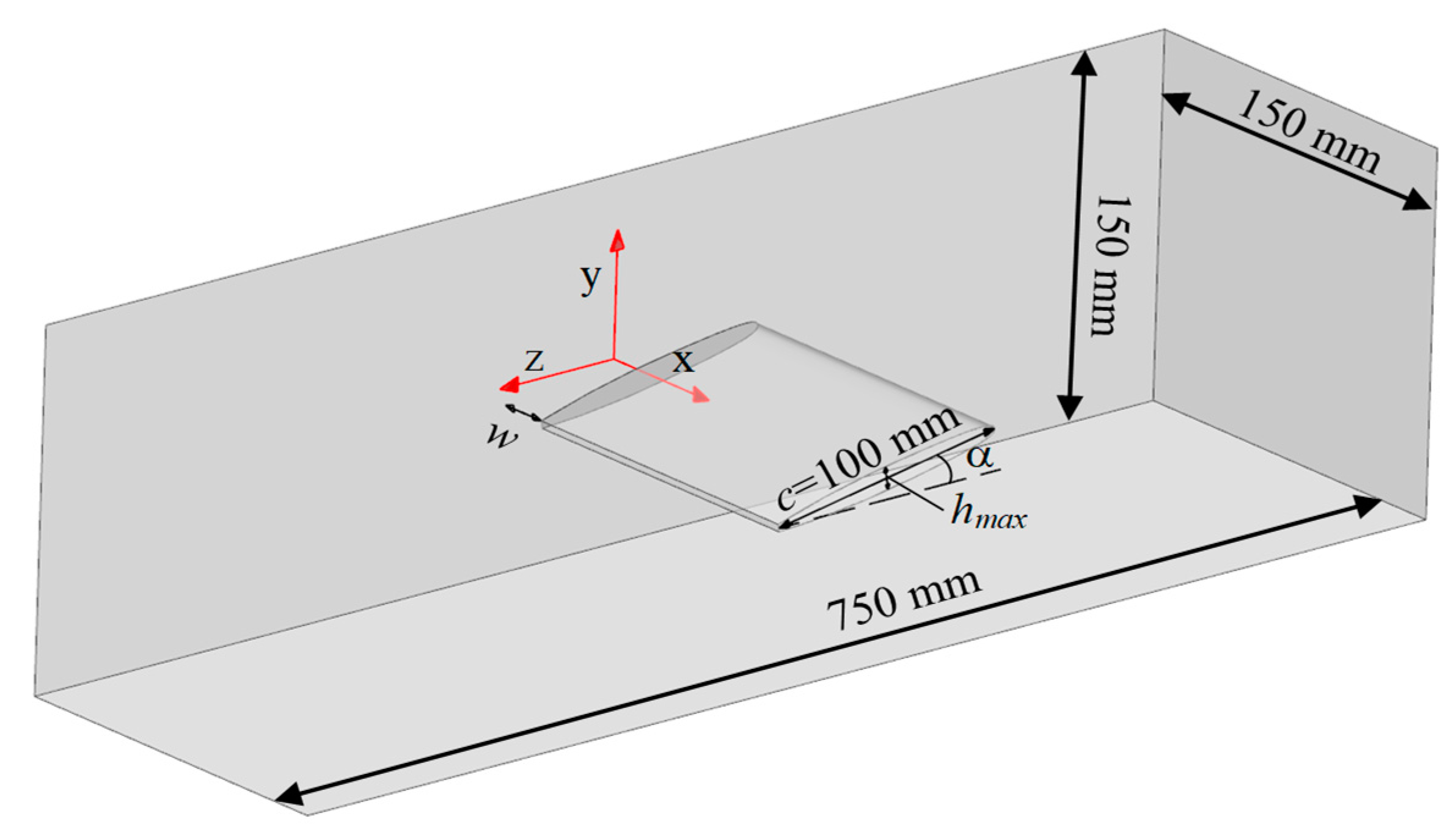

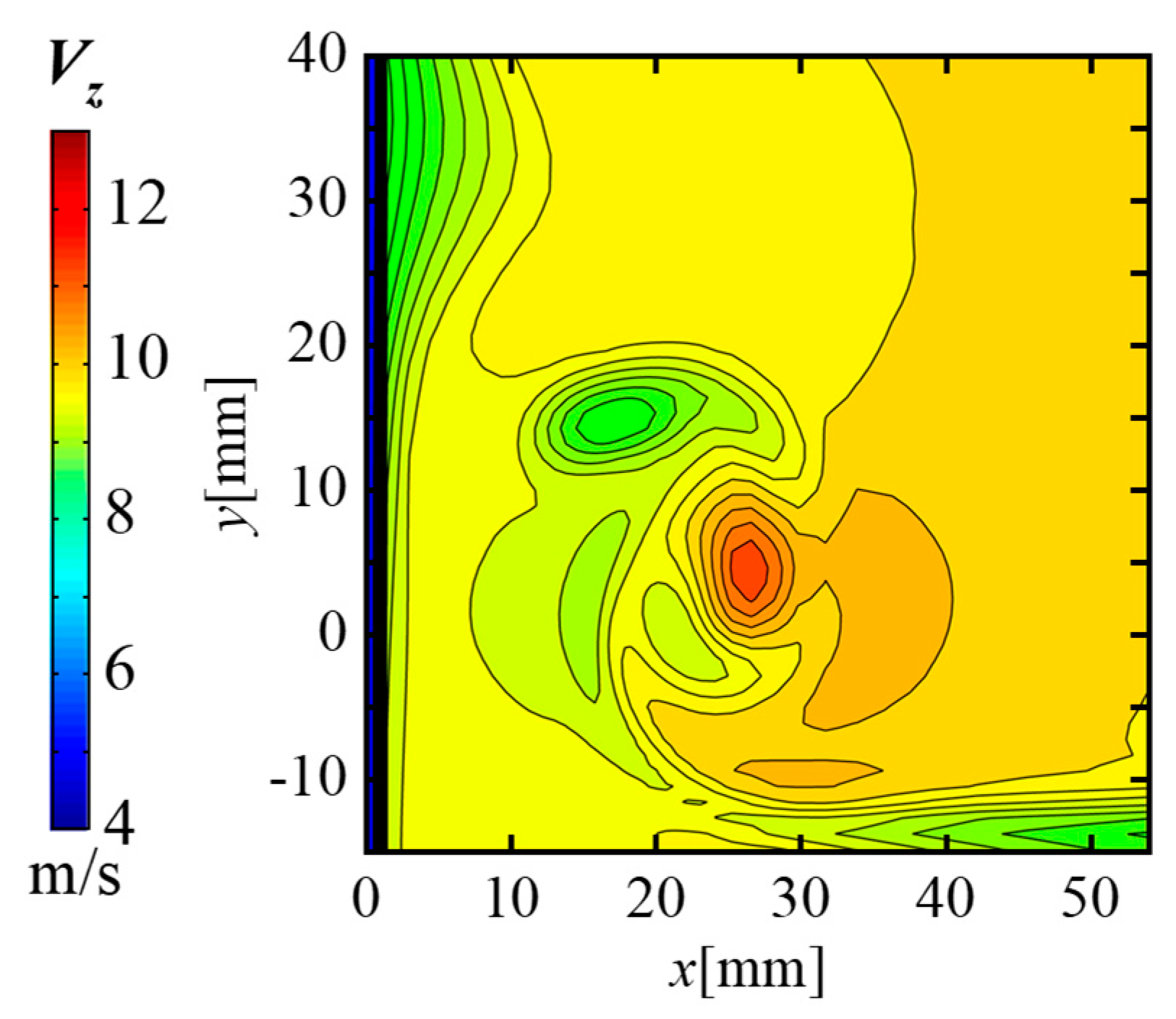
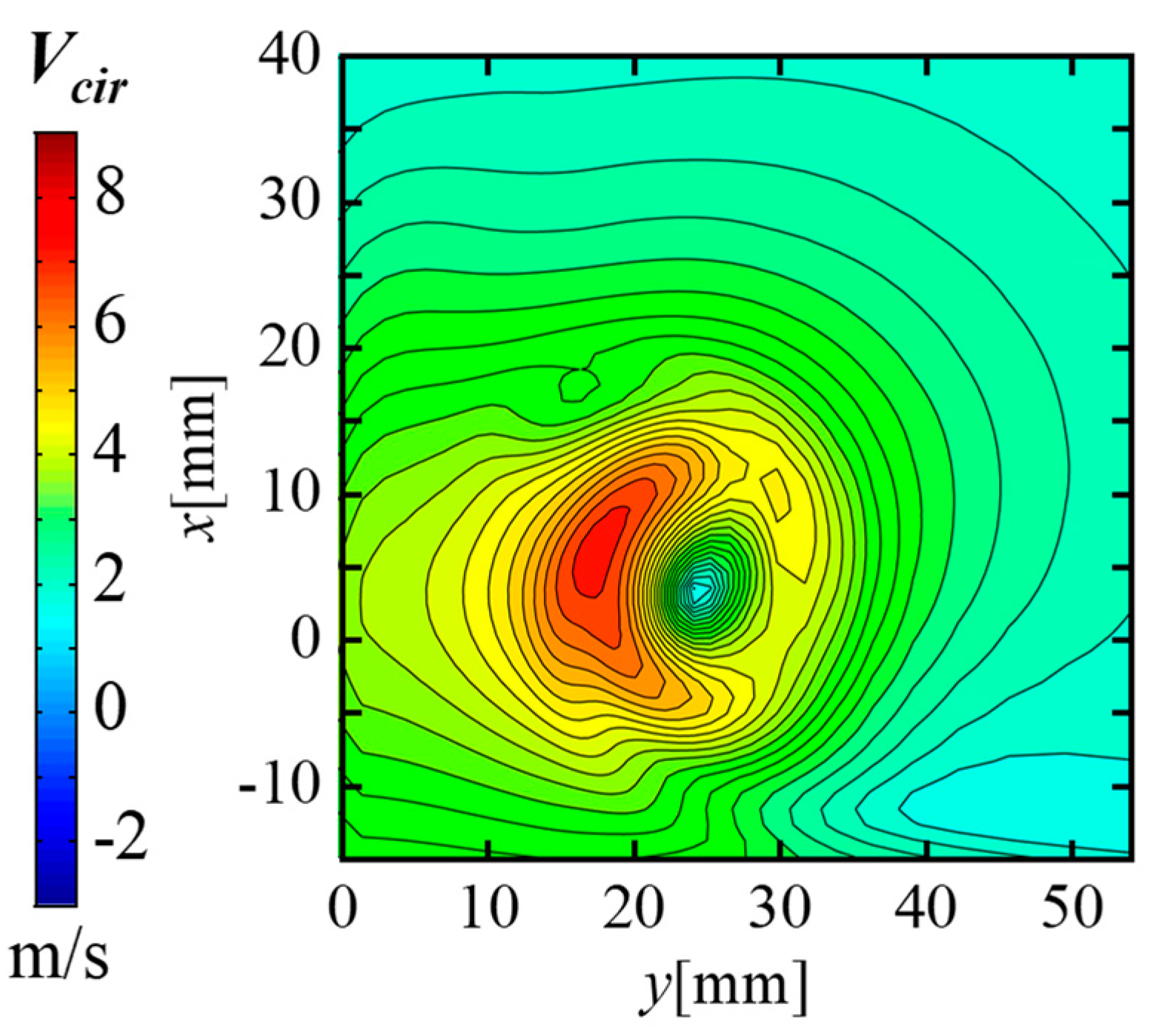
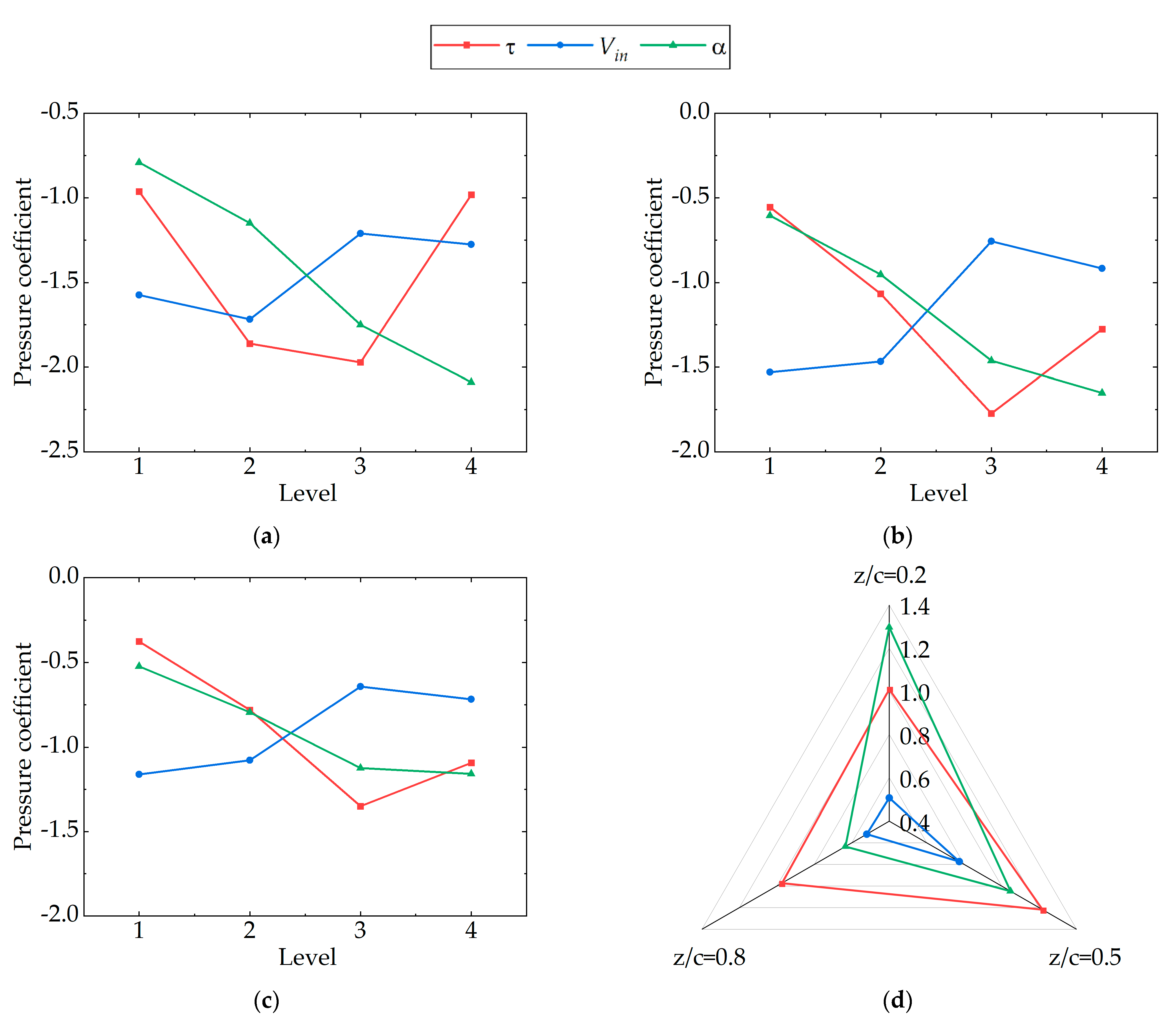

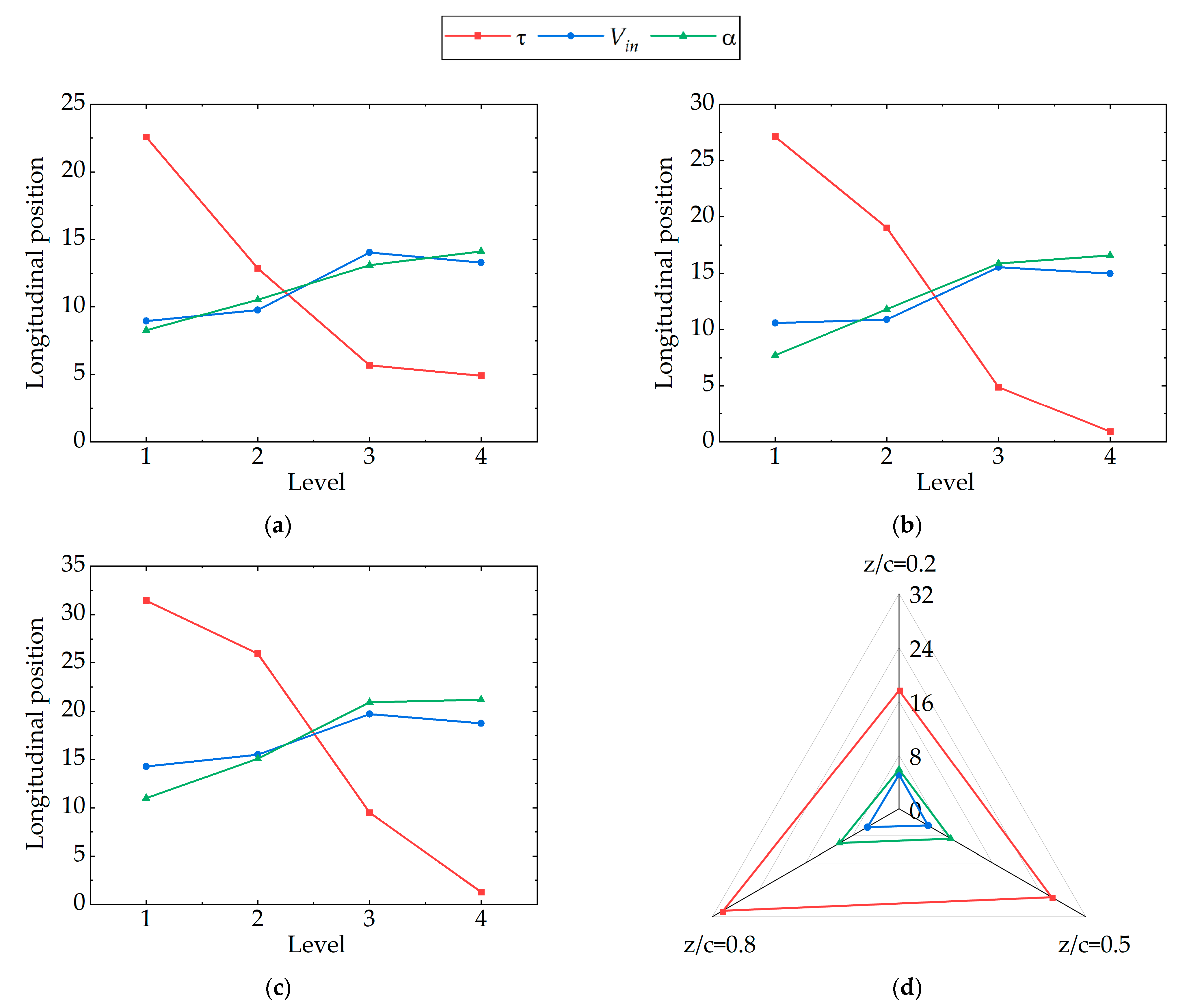
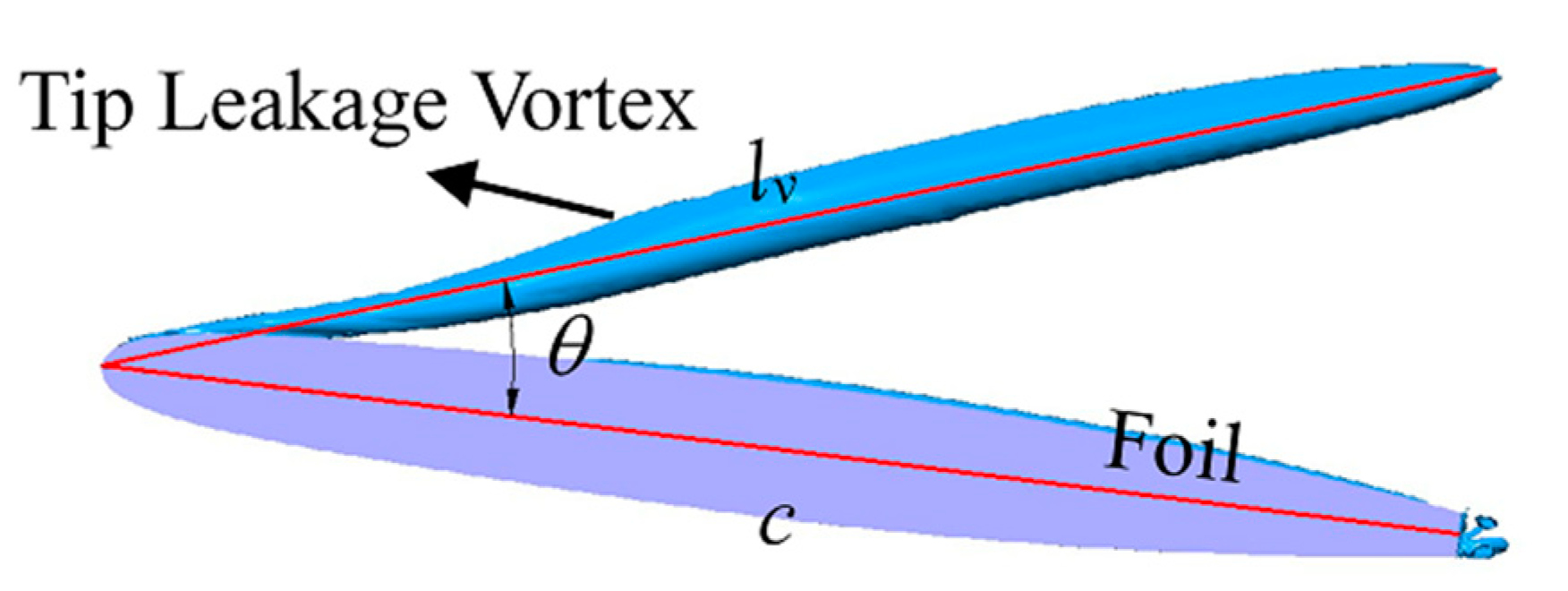




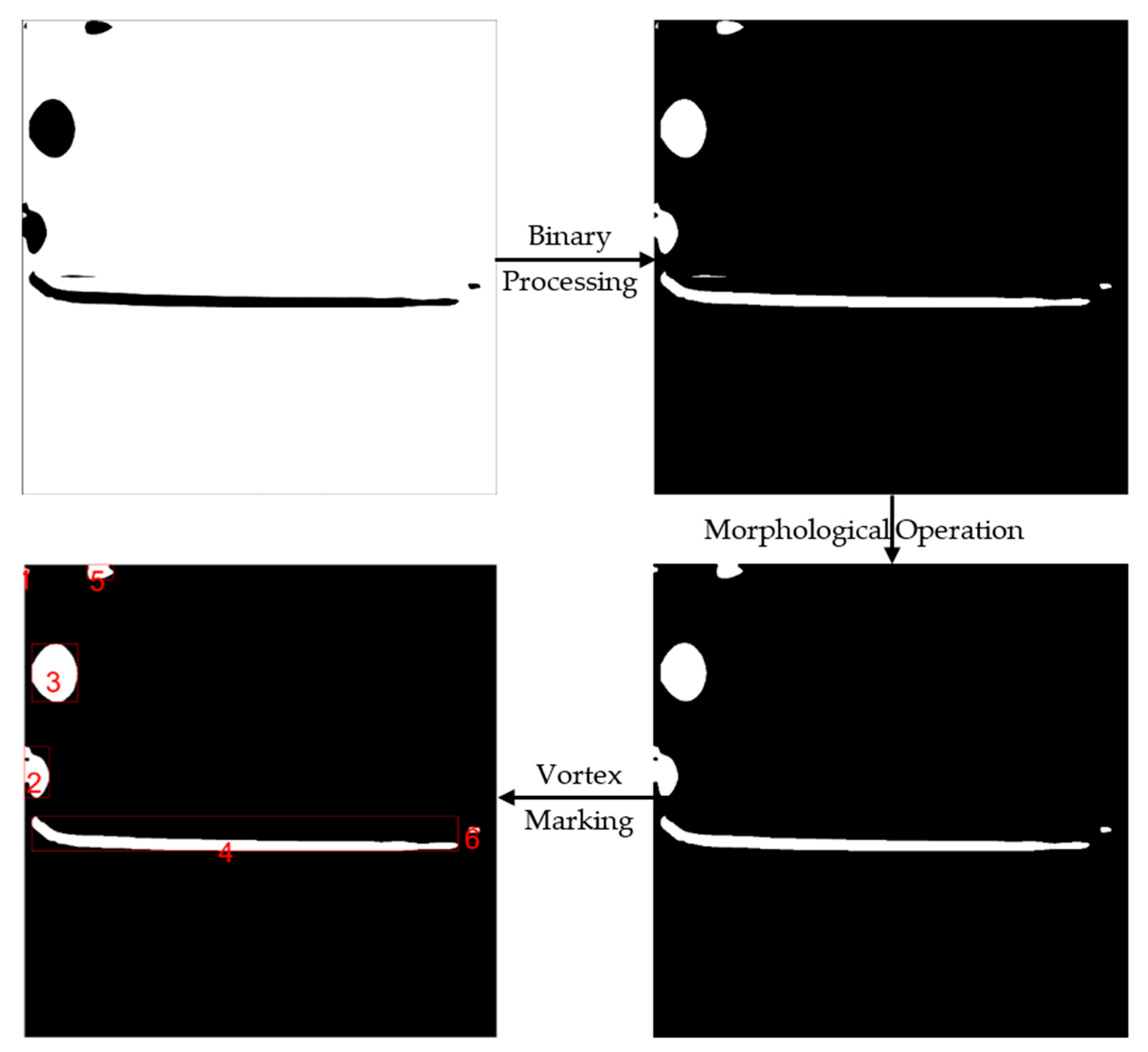
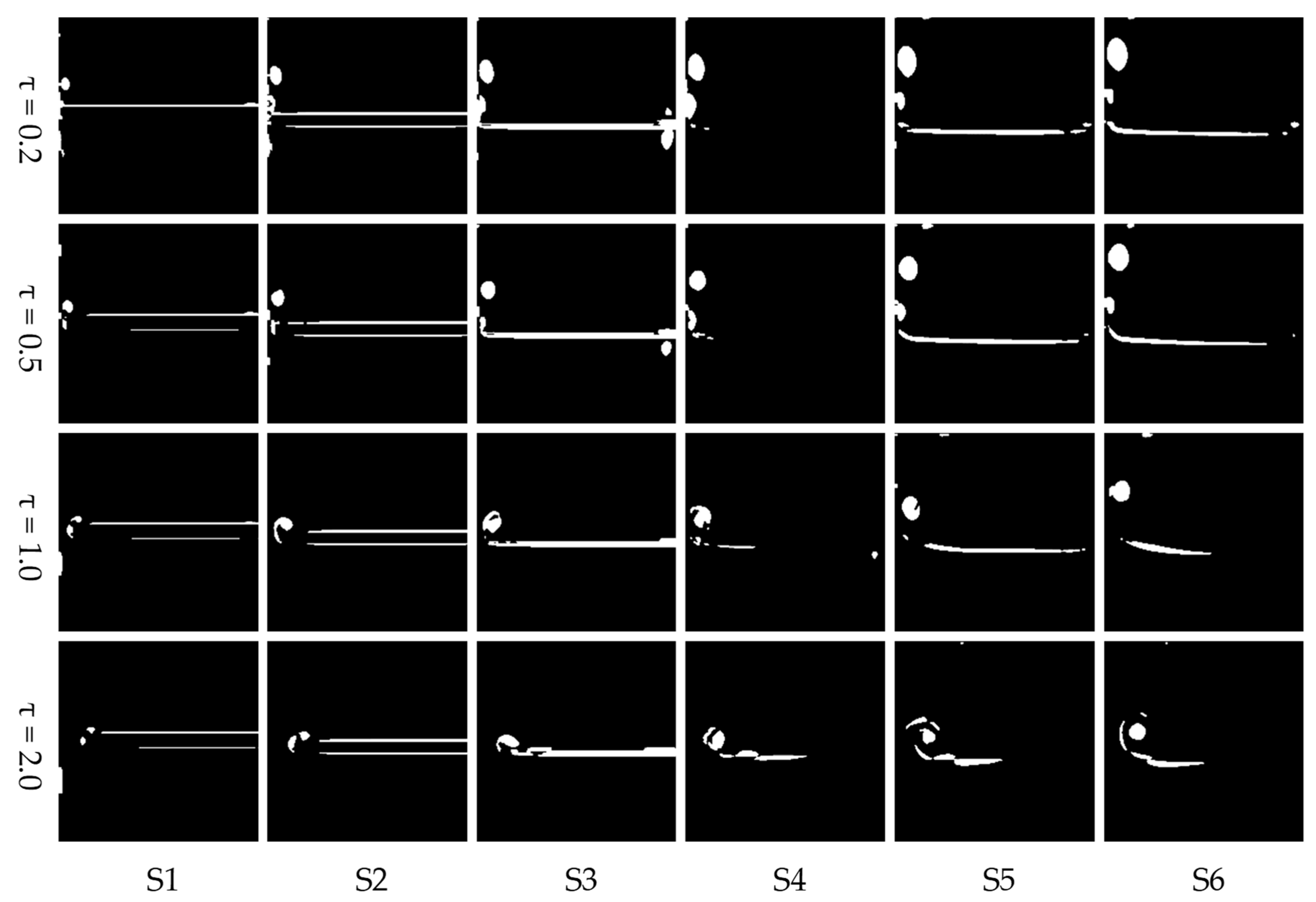

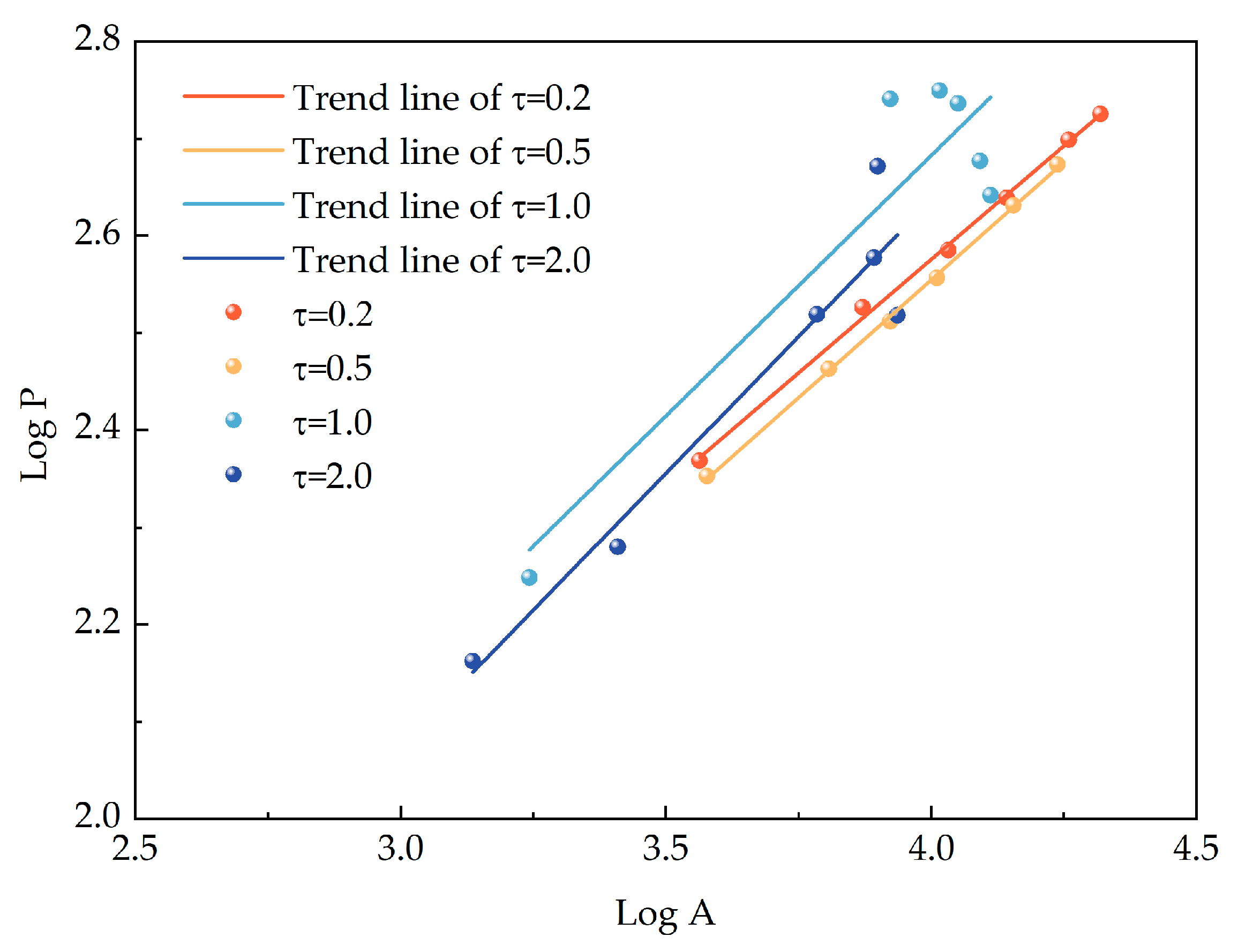
| Test Number | Factor | Test Number | Factor | ||||
|---|---|---|---|---|---|---|---|
| τ [-] | Vin [m/s] | α [°] | τ [-] | Vin [m/s] | α [°] | ||
| 1 | 0.2 | 5 | 5 | 9 | 1 | 5 | 10 |
| 2 | 0.2 | 10 | 7 | 10 | 1 | 10 | 12 |
| 3 | 0.2 | 15 | 10 | 11 | 1 | 15 | 5 |
| 4 | 0.2 | 20 | 12 | 12 | 1 | 20 | 7 |
| 5 | 0.5 | 5 | 7 | 13 | 2 | 5 | 12 |
| 6 | 0.5 | 10 | 5 | 14 | 2 | 10 | 10 |
| 7 | 0.5 | 15 | 12 | 15 | 2 | 15 | 7 |
| 8 | 0.5 | 20 | 10 | 16 | 2 | 20 | 5 |
| Grid Scheme | Number of Grids | Lift Coefficient | GCI (%) | Drag Coefficient | GCI (%) |
|---|---|---|---|---|---|
| 1 | 1,426,737 | 0.1115 | 0.18 | 0.0081 | 1.25 |
| 2 | 3,028,611 | 0.1116 | 0.008 | ||
| 0.13 | 0.84 | ||||
| 3 | 6,095,862 | 0.1117 | 0.008 |
| Case | Section | S1 | S2 | S3 | S4 | S5 | S6 |
|---|---|---|---|---|---|---|---|
| τ = 0.2 | Number of vortices | 4 | 9 | 6 | 5 | 9 | 7 |
| Dt | 1.329 | 1.305 | 1.282 | 1.274 | 1.267 | 1.262 | |
| τ = 0.5 | Number of vortices | 7 | 7 | 5 | 5 | 6 | 8 |
| Dt | 1.315 | 1.294 | 1.281 | 1.275 | 1.266 | 1.262 | |
| τ = 1.0 | Number of vortices | 6 | 3 | 3 | 7 | 7 | 4 |
| Dt | 1.387 | 1.397 | 1.369 | 1.351 | 1.308 | 1.285 | |
| τ = 2.0 | Number of vortices | 6 | 4 | 2 | 4 | 6 | 5 |
| Dt | 1.379 | 1.337 | 1.37 | 1.324 | 1.331 | 1.28 |
| τ | C0 | C1 | R2 |
|---|---|---|---|
| 0.2 | 0.707 | 0.467 | 0.997 |
| 0.5 | 0.616 | 0.485 | 0.999 |
| 1 | 0.539 | 0.536 | 0.812 |
| 2 | 0.387 | 0.562 | 0.893 |
Disclaimer/Publisher’s Note: The statements, opinions and data contained in all publications are solely those of the individual author(s) and contributor(s) and not of MDPI and/or the editor(s). MDPI and/or the editor(s) disclaim responsibility for any injury to people or property resulting from any ideas, methods, instructions or products referred to in the content. |
© 2023 by the authors. Licensee MDPI, Basel, Switzerland. This article is an open access article distributed under the terms and conditions of the Creative Commons Attribution (CC BY) license (https://creativecommons.org/licenses/by/4.0/).
Share and Cite
Hu, Z.; Wu, Y.; Li, P.; Xiao, R.; Tao, R. Comparative Study on the Fractal and Fractal Dimension of the Vortex Structure of Hydrofoil’s Tip Leakage Flow. Fractal Fract. 2023, 7, 123. https://doi.org/10.3390/fractalfract7020123
Hu Z, Wu Y, Li P, Xiao R, Tao R. Comparative Study on the Fractal and Fractal Dimension of the Vortex Structure of Hydrofoil’s Tip Leakage Flow. Fractal and Fractional. 2023; 7(2):123. https://doi.org/10.3390/fractalfract7020123
Chicago/Turabian StyleHu, Zilong, Yanzhao Wu, Puxi Li, Ruofu Xiao, and Ran Tao. 2023. "Comparative Study on the Fractal and Fractal Dimension of the Vortex Structure of Hydrofoil’s Tip Leakage Flow" Fractal and Fractional 7, no. 2: 123. https://doi.org/10.3390/fractalfract7020123
APA StyleHu, Z., Wu, Y., Li, P., Xiao, R., & Tao, R. (2023). Comparative Study on the Fractal and Fractal Dimension of the Vortex Structure of Hydrofoil’s Tip Leakage Flow. Fractal and Fractional, 7(2), 123. https://doi.org/10.3390/fractalfract7020123







